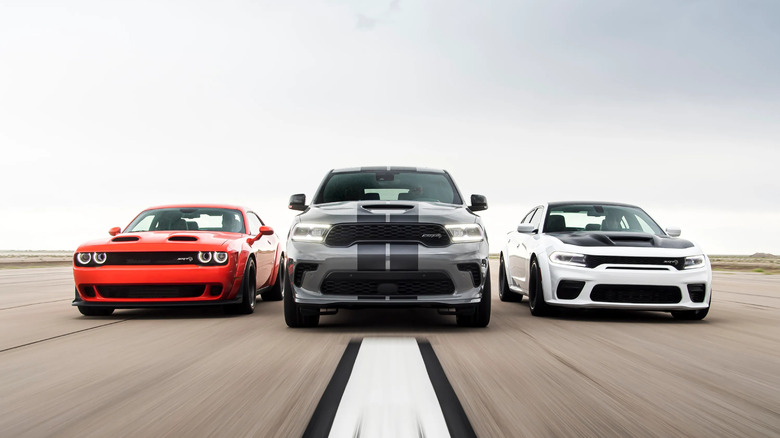What Does SRT Mean On A Dodge And How Is It Different From RT?
Dodge's performance lineup has remained one of the brand's focal points for decades, arguably reaching its first zenith in the 1960s. It was during the muscle car era that we witnessed the meteoric rise of a number of iconic names in automotive culture, both in distinct models such as the Mustang and in trim levels such as the GTO. Dodge in particular witnessed an automotive renaissance, fielding a huge diversity of legendary vehicles from the small but agile Dart to the infamous B-bodies like the Coronet and Charger. Most muscle cars of this era boasted high-horsepower engines from otherwise pedestrian midsize vehicles, and if you wanted such a car with a Dodge badge, the answer was — and remains — the R/T, or Road/Track.
Meanwhile, SRT, which stands for Street and Racing Technology, emerged from a different era, one marked by the rise of specialist factory-tuning firms such as Ford's SVO (Special Vehicle Operations), which later became SVT (Special Vehicle Team); Toyota's TRD (Toyota Racing Development), BMW's M-division, and so on. In effect, it's Dodge's take on these examples, with each SRT vehicle representing a high-performance halo car in the vehicle lineup. Each car boasts a far higher horsepower and general tuning level than the parent model, such as the Challenger Hellcat versus the standard Challenger R/T. At one point, Chrysler even launched the SRT name as its own standalone brand similar to Ram Trucks, though this proved an unsuccessful venture, and it was later reincorporated into Dodge, where it sits today. This nameplate features its own rich story entirely separate from the R/T trim level.
Birth of the Street and Racing Technology nameplate
Unlike the R/T name, which traces its lineage back to 1967 with the introduction of the Coronet R/T, Street and Racing Technology didn't emerge until 1989. And right from its inception, the SRT name was always associated with speed. It began life as "Team Viper," the original design team behind the Dodge Viper. This was effectively a handful of some of Dodge's finest engineers, mechanics, and racing enthusiasts locked inside an office and left unsupervised for several years. The fruits of their labor laid the foundation for Dodge's penchant for modern American muscle, and the SRT nameplate carried on this legacy alongside and beyond the Viper's own timeframe.
After the Viper's success, Chrysler incorporated a branch of "Team Viper," named "Team Prowler," to develop the eponymous hotrod-themed Plymouth/Chrysler Prowler. This later merged to become Specialty Vehicle Engineering, or SVE, before being renamed to Performance Vehicle Operations to differentiate it from the similarly named Ford SVT division. The history of SRT is quite fascinating.
Suffice it to say, SRT quickly became Chrysler's high-performance arm focused primarily, but not exclusively, on producing fast versions of the company's regular products. Over the years, these included many nameplates such as the Neon, Charger, Challenger, and Durango, and it extended to other manufacturers such as the Jeep Grand Cherokee SRT series, Chrysler 300 SRT, the Hellcat engine, and more.
Not your average trim level
Arguably the greatest distinction between the SRT and R/T names is the level of performance one can expect from each. Typically, the R/T name is associated with a high-performance trim level of the standard car, like a Challenger R/T, for example. The modern Dodge Challenger R/T came in two powertrain flavors: the ubiquitous 5.7L Hemi or the 392 Scat Pack with the 485-horsepower 6.4L V8.
Meanwhile, a Challenger with an SRT badge features a substantially different level of performance, boasting anywhere from 707 horsepower from its supercharged 6.2L up to a whopping 1,025 horsepower from the SRT Demon 170, making it one of the few reasonably priced production cars with over 1,000 horsepower. This trend continues across all of Stellantis' lineup, ranging from the Jeep Hellcats to the Charger SRT, and so on, with these vehicles representing the absolute top-tier factory performance of their parent models.
There have been various SRT-labeled vehicles over the years, and while they're absolute monsters today, they all trace their origins back to the unassuming SRT Neon. Despite its seemingly humble beginning, however, the SRT Neon produced almost double the horsepower of the base-model variant, a trend that SRT continues more than any other. Currently, the only remaining Dodge SRT on sale is the 2025 Durango SRT Hellcat, though that may change following Chrysler's recent revival of the Hemi and its incorporation into the Charger and Ram truck. However, the R/T retains its spot as the current top trim level on the 2025 Charger and other models.


